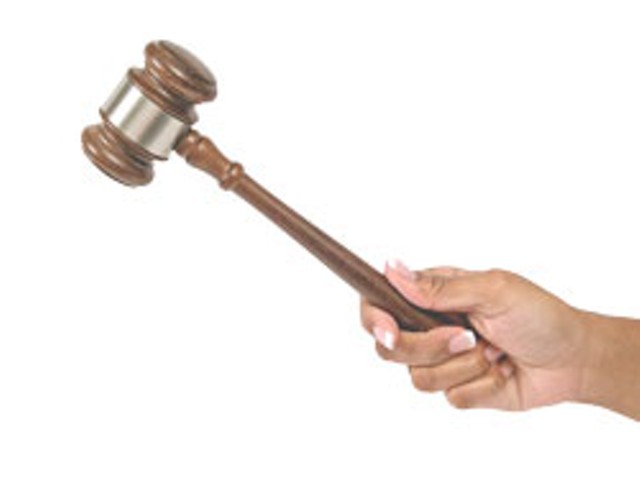Published March 3, 2010 at 9:09 a.m.
In a recent conversation with my 6-year-old daughter, Samira, I mentioned that I’d had lunch with a judge — a female judge. Samira asked, “You mean the kind of judge that wears a black robe and says, ‘You’re guilty!’?”
“Yes,” I said. “Why do you ask?”
Samira told me, to my alarm, that she thought only boys could be judges. Why? “Because all the judges I’ve seen are boys, and they’re always so mean. Girls aren’t mean enough to be judges, are they?”
I told her that you don’t have to be mean to be a judge, just smart and wise. “And girls are smart and wise.”
At that, Samira, pulling on my black coat, called to her 4-year-old brother, “Hey, Elias, let’s play court. I’m the judge, and you’re going to jail!”
I was in high school when President Ronald Reagan appointed Sandra Day O’Connor to the United States Supreme Court. I had never even seen a woman lawyer before then, much less a woman judge. There was certainly a growing number of female attorneys by the mid-1980s, but I didn’t know any by name. I remember standing in the grocery store, transfixed by the People magazine with O’Connor on the cover, and, just like my daughter today, I had a desire to go home and “play court.” O’Connor’s appointment to the bench was the single most important public event in my life, because at that moment I saw my own potential as limitless.
So, while I was not surprised by my daughter’s exuberance at realizing that she, too, could sit as Solomon, I was shocked that, in 2010, a 6-year-old had internalized the idea that men were the ones primarily entitled to positions of power. Granted, her frames of reference are Disney movies and the classic literature that I read her before bed. But in these fictional worlds, it’s men who deal justice, and apparently in a not-so-nice way. Never mind that her own mother is a law professor.
What difference does it make if there are women judges? It matters that children see people who look like them doing things they might aspire to. It matters that young people have role models — if Samira and her girlfriends don’t see women in black robes, they don’t see themselves in black robes. And it matters that, in a functional democracy, each of us believes our talents and determination — not our gender, color, class or creed — decide our destiny.
One thing that makes me crazy about this “woman this-or-that” conversation — which I can’t believe some people are still having — is the presumption that, but for being female, a woman wouldn’t have been appointed to a judgeship. Of course, it would be disingenuous to suggest that gender was not an important consideration when Reagan appointed O’Connor, or President Clinton appointed Ruth Bader Ginsburg, or President Obama appointed Sonia Sotomayor. It was also an important consideration when Senator Leahy nominated Christina Reiss to the federal bench, making her Vermont’s first female to hold that job. Problem is, the “gender factor” often becomes the whole story, so that a woman’s accomplishments and credentials are obscured or dismissed.
There should no longer be any dispute that intelligence and judgment are evenly distributed throughout the population, and that men are no more innately suited to being judges than are women. But this premise was a long time coming. The nation’s first female attorney, Myra Bradwell, apprenticed with her husband and passed the Illinois bar examination, but the state refused to grant her a license to practice because she was a woman. Bradwell took her case all the way to the United States Supreme Court, which upheld the state’s rule that only men could be lawyers. In a concurring opinion, Justice Bradley wrote, “The paramount destiny and mission of woman [sic] are to fulfill the noble and benign offices of wife and mother. This is the law of the Creator.”
That was in 1872; the belief that women were not biologically or socially equipped for the demands of the law lingered for many generations more.
When Illinois eventually changed its law, Bradwell became a lawyer and went on to argue before the Supreme Court. Her success opened the door to other women entering the profession. In Vermont, Jessie Bigwood was the first female attorney, in 1902. When she won her initial case at Chittenden County Superior Court, the local newspaper reported that she “was not in the business for fun.”
It was 10 years before another female attorney joined Bigwood in Vermont. It was 18 years before the passage of the 19th Amendment giving women the right to vote. And it was not until 1978 that the total number of women admitted to the bar in Vermont exceeded 100. In other words, it was a long, slow journey to a legitimizing critical mass of women attorneys.
The Vermont Bar Association’s “First Hundred” report, which documents the lives of those first 100 female attorneys, reveals that gender discrimination in the Vermont bar was common. “One woman lawyer, admitted in 1975, recalled that at her bar admission ceremony, the ‘lady lawyers’ were still segregated from the male admittees,” reads one example. While such blatant discrimination no longer exists, female attorneys can still face the kind of subtle, unspoken, unconscious biases expressed by Justice Bradley in 1872.
The first woman judge elected in Vermont was Beatrice Brown, who served the Marlboro District Probate Court from 1948 to 1964. Interestingly, she was active in the antinuclear movement and a vocal opponent of Vermont Yankee. Among the other famous firsts is Consuelo Northrup Bailey. The seventh woman appointed to the Vermont bar, she was the first female attorney in the state to try a murder case, the first female to serve as Speaker of the Vermont House and the nation’s first woman to be elected lieutenant governor, in 1954. It was not until 1990 that Gov. Madeleine Kunin, Vermont’s first — and still only — female governor, appointed the first woman to the Vermont Supreme Court: Denise Johnson. She remains on the bench today and was joined in 1997 by the second female, Justice Marilyn Skoglund.
Since Jessie Bigwood’s time in the early 20th century, the number of women joining the Vermont bar has steadily increased. So it’s somewhat shocking that the first woman on the federal bench in Vermont was not seated until this year. Given that women make up 31 percent of the bar nationally, you might expect to find a similar percentage among federal appointees. Alas, women hold just 25 percent of federal judgeships. I suspect plenty of male judges out there got their appointments not just because of superior intelligence and wisdom but because of the “old boys’ network.” Make no mistake, gender preference — for men — has always been a factor in judicial appointments.
Judge Reiss has finally cracked this glass ceiling, but a question remains: Do women judge any differently from men, as my daughter seems to think? The answer: It depends. In particular, it depends on the kind of case. A judge’s gender is known to make a significant difference in disputes where gender plays a role in the conduct of the parties — such as sexual harassment or discrimination in employment claims. In a recent study that looked at federal appellate cases of that nature, plaintiffs were more than twice as likely to prevail if a female judge was on the panel. This study was consistent with others that have found women judges more likely to interpret the facts of cases as being harassment or discrimination as opposed to innocent conduct. No studies document any difference in the way men and women judge outside of these kinds of cases.
That said, Judge Reiss’ appointment is symbolically important and gives us something to celebrate during Women’s History Month. Judge Reiss will soon take up chambers in Rutland. And I’ll be bringing both of my children there to see her in action — a much better field trip than going to the latest Disney princess movie.
Cheryl Hanna teaches constitutional law at Vermont Law School.
More By This Author
Speaking of Justice, local Issues
-

Best rock artist or group
Aug 1, 2018 -

Opinion: Should Rape Victims Get Custody Rights?
Feb 26, 2014 -

At the Junction of State and Federal Law, I-91 Checkpoint Becomes Site of Legal Collision
Feb 5, 2014 -

Maple Makeover? Vermonters Discover a New Sugaring Technique
Feb 5, 2014 -

Disharmony on Prospect Street: A Dispute Between Neighbors Strikes a Sour Note
Feb 5, 2014 - More »
Comments
Comments are closed.
From 2014-2020, Seven Days allowed readers to comment on all stories posted on our website. While we've appreciated the suggestions and insights, right now Seven Days is prioritizing our core mission — producing high-quality, responsible local journalism — over moderating online debates between readers.
To criticize, correct or praise our reporting, please send us a letter to the editor or send us a tip. We’ll check it out and report the results.
Online comments may return when we have better tech tools for managing them. Thanks for reading.













































